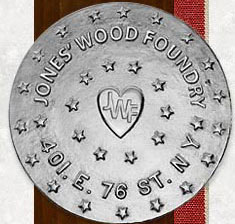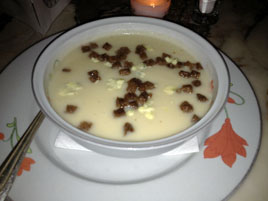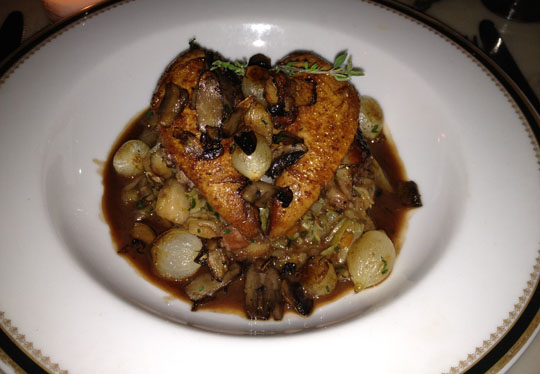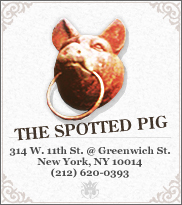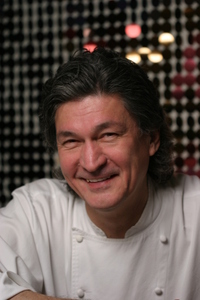Slightly Oliver
 Monday, January 9, 2012 at 08:08PM
Monday, January 9, 2012 at 08:08PM 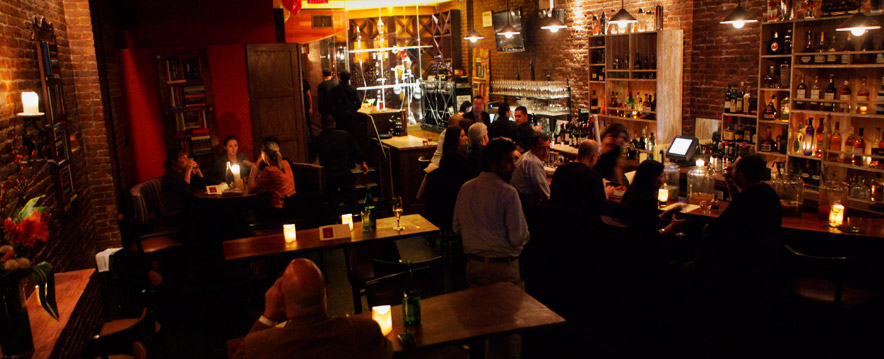
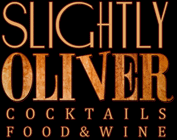 Slightly Oliver is a new “cocktail-themed gastropub” on the Upper West Side. That description is both a selling point and a constraint, the former because there isn’t much like it nearby, the latter because in any other neighborhood it would seem derivative.
Slightly Oliver is a new “cocktail-themed gastropub” on the Upper West Side. That description is both a selling point and a constraint, the former because there isn’t much like it nearby, the latter because in any other neighborhood it would seem derivative.
The basic idea, we must admit, has been tried before—but not here. If you’re in the area, you ought to be delighted to find Slightly Oliver (Cockney slang for “slightly drunk”), which is unique, as far as I know, on the Upper West Side.
The formula is tweaked for uptown sensibilities. The “commonwealth-inspired” menu (mostly comfort-food standards) breaks no new ground, but it is extremely well made. We tried eight dishes, and I’d be happy to have them all again. Prices are low: most entrées are $20 or less. Cocktails are in three categories: punches ($7); house recipes (described somewhat annoyingly as “tasty” cocktails) ($9), and prohibition-era classics ($12) — a good deal less than you’d pay downtown.
The owner is Stanton DuToit, who also runs Tolani Wine Restaurant a few blocks away, and formerly Sojourn on the Upper East Side. I didn’t much care for Tolani, though I haven’t been back in a while. The idea here seems more carefully edited and focused. DuToit is a trained winemaker, and the wine lists are a strength at both restaurants. As at Tolani, there’s a glass-enclosed wine room visible from the dining room; here, it shares space with a mad-scientist chemistry set that’s used to make home-brew infusions.
There are three connected spaces: a bar in front, a narrow corridor with several comfortable booths separated by gauze curtains, and a dining room in back. It feels more spacious and comfortable than most downtown restaurants with a similar proffer. We visited on New Year’s Day, when neither of the two back rooms were very crowded. There are plenty of exposed hard surfaces (brick, wooden tables) that could reflect sound, if the space were full.
Dislosure: My visit wasn’t pre-arranged with the management, but Mr. DuToit recognized me. He sent out eleven(!) different cocktails, all at no charge, and four comped dishes, in addition to the four we ordered and paid for.
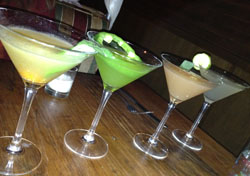 We sampled a wide swath of the cocktail menu. There is a tendency to sweetness; I best liked the ones with offsetting bitter or spicy flavors. Among the punches, try the Last Night in Paris (Claro rum, spiced rum, absinthe, fresh mint reduction, pink grapefruit juice, house blended spices, whisky bitters).
We sampled a wide swath of the cocktail menu. There is a tendency to sweetness; I best liked the ones with offsetting bitter or spicy flavors. Among the punches, try the Last Night in Paris (Claro rum, spiced rum, absinthe, fresh mint reduction, pink grapefruit juice, house blended spices, whisky bitters).
Among the house cocktails (left), I preferred Oliver’s Cilantro (infused gin, Lillet Blanc, house made sour, and cucumber) and the Slightly Green Martini (vodka, green pepper reduction, dill elixir, house made sour mix). I did wince at the idea of calling something a martini that isn’t.
I especially liked the old standards, even if by then I was too, er, Oliver to finish them. The Negroni and the Manhattan, while both recognizable as the classics they are, both had an extra tang of spice that I don’t recall in other versions of them.

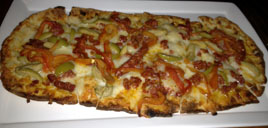
Over now to the food, the Chicken Liver & Foie Gras Pâté ($8; above left) was luscious and creamy, though there is not enough toast for it. The staff offered to send more, but I declined, knowing how much was coming.
There are several pizza-like dishes, which they call “flats.” The Spaniard ($12; above right) with chorizo, manchego, and piquillo peppers, was especially good.
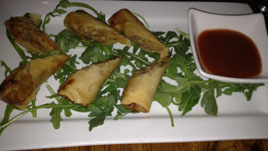

There’s a section of the menu called “Stacks” (all $16) and though I’ve no complaints with these items, perhaps they’re comparatively skippable. Duck Spring Rolls (above left) made for a tasty snack food. Kobe Beef Sliders and Bittermilk Chicken Sliders (below left) were just fine, although you’ve had others just as good elsewhere.
Swiss Chard and Ricotta Ravioli ($14; above right) probably violated the legal limit on the amount of butter and cream allowed in one dish, but, oh my! They were absolutely fantastic.
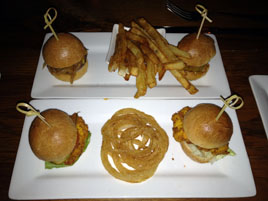
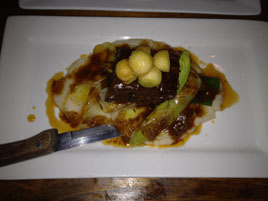
There’s also an excellent rendition of braised short ribs ($18; above right), served here with celery root purée, braised leeks, and apple gastrique.
 I would describe the Sticky Toffee Pudding ($8; right) as my dessert of the year, but it was New Year’s Day, so that isn’t saying much. I don’t remember a more enjoyable dessert last year either. Other desserts shown on the menu (a pecan bourbon pie, an apple–huckleberry crisp) sound equally appealing.
I would describe the Sticky Toffee Pudding ($8; right) as my dessert of the year, but it was New Year’s Day, so that isn’t saying much. I don’t remember a more enjoyable dessert last year either. Other desserts shown on the menu (a pecan bourbon pie, an apple–huckleberry crisp) sound equally appealing.
If I have a concern about Slightly Oliver, it’s the over-reliance on consultants. Jason Hicks of Jones Wood Foundry helps out in the kitchen (Mr. DuToit says he is there twice a week). Pre-opening publicity also included cocktail whiz Albert Trummer. You’d prefer to see a restaurant grow organically, rather than leaning on people whose main focus is elsewhere.
But in these early days the cocktails are mostly quite good, and if the menu is somewhat predictable by downtown standards, at least the kitchen is acing it. The location at Amsterdam & 85th doesn’t attract a destination crowd, so if Slightly Oliver is going to work, neighborhood folk will have to embrace it, which they should.
Slightly Oliver (511 Amsterdam Ave. between 84th/85th Streets, Upper West Side)


